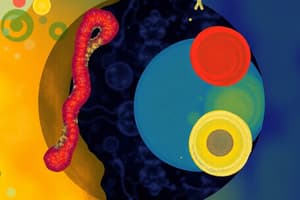Podcast
Questions and Answers
Explain the process of mitosis and how it differs from meiosis in terms of the types of daughter cells produced.
Explain the process of mitosis and how it differs from meiosis in terms of the types of daughter cells produced.
Mitosis is the process of cell division that results in two identical daughter cells, each with the same number of chromosomes as the parent cell. Meiosis, on the other hand, results in four non-identical daughter cells with half the number of chromosomes as the parent cell, and is involved in the formation of gametes (sex cells).
Describe the appearance of chromosomes at different stages of the cell cycle and how they can be identified. Explain what happens to chromosomes during each stage of mitosis.
Describe the appearance of chromosomes at different stages of the cell cycle and how they can be identified. Explain what happens to chromosomes during each stage of mitosis.
During the cell cycle, chromosomes can be identified as thread-like structures that condense into visible structures as cells prepare for division. In mitosis, chromosomes go through stages such as prophase, metaphase, anaphase, and telophase, where they condense, align at the cell's center, separate, and finally decondense, respectively.
Where does mitosis occur in plant cells, and how is it different from animal cells?
Where does mitosis occur in plant cells, and how is it different from animal cells?
Mitosis occurs in the meristem tissue of plant cells, which is responsible for growth and repair. One key difference from animal cells is that plant cells have a rigid cell wall, so during cytokinesis, a new cell wall called the cell plate forms between the two daughter cells.
Describe how oxygen and glucose are transported across cell membranes. Interpret a graph depicting the transport of these molecules.
Describe how oxygen and glucose are transported across cell membranes. Interpret a graph depicting the transport of these molecules.
Describe the appearance of chromosomes at different stages of the cell cycle and how they can be identified. How does mitosis differ from meiosis in terms of the types of daughter cells produced? Where does mitosis occur in plant cells, and how is it different from animal cells?
Describe the appearance of chromosomes at different stages of the cell cycle and how they can be identified. How does mitosis differ from meiosis in terms of the types of daughter cells produced? Where does mitosis occur in plant cells, and how is it different from animal cells?
Explain what happens to chromosomes during each stage of mitosis. Using a provided scale bar on an image, calculate the size of the chromosomes.
Explain what happens to chromosomes during each stage of mitosis. Using a provided scale bar on an image, calculate the size of the chromosomes.
Describe how oxygen and glucose are transported across cell membranes. Interpret a graph depicting the transport of these molecules.
Describe how oxygen and glucose are transported across cell membranes. Interpret a graph depicting the transport of these molecules.
Explain the role of ribosomes and mitochondria in cellular function, including the transport of molecules across membranes. How does mitochondria contribute to ATP production?
Explain the role of ribosomes and mitochondria in cellular function, including the transport of molecules across membranes. How does mitochondria contribute to ATP production?
Flashcards are hidden until you start studying




